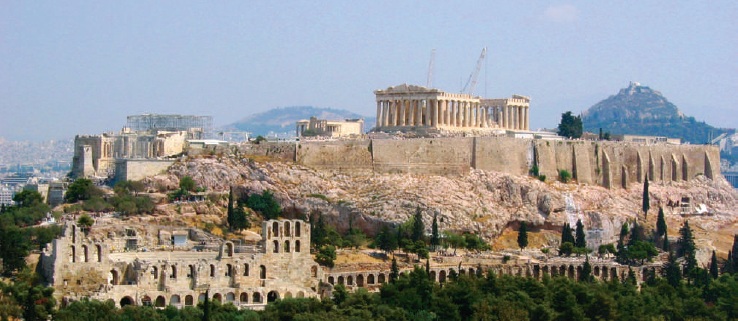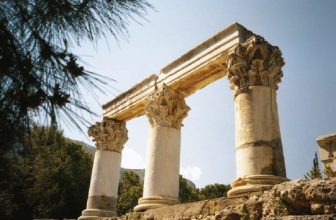The word acropolis literally means the higher, fortified part of a city. While there may be many of these in Greece, when we speak of the Acropolis, most understand the reference to be to the Acropolis of Athens. The Acropolis sits more than 500 feet above the plain of Attica in the city of Athens, bordered on three sides by cliffs and accessible by foot on only one side. Its geography made it a natural fortress during the iron- age beginnings of Athens, and it functioned primarily as a fort until sometime after the end of the Persian Wars (479 BC).
Evidence of human habitation dates from the Neolithic. Through the centuries, the Acropolis has served the people of Athens as a place of residence, palaces, centers of worship, a citadel, and monuments to their gods and goddesses. One such temple was dedicated to Athena, the city’s patron goddess, as early as 650 BC.
Major Monuments
 On the Acropolis, major monuments include the Parthenon, the Erechtheion, the Temple of Athena Nike, and the Propylaea.
On the Acropolis, major monuments include the Parthenon, the Erechtheion, the Temple of Athena Nike, and the Propylaea.
The Parthenon
Built around 440 BC and dedicated to the city’s patron goddess Athena Parthenos, the Parthenon’s creators were Pericles, the Athenian sculptor Pheidias, and architects Kallikrates and Iktinos. The cella or center of the temple was designed to shelter Pheidias’s statue of Athena. On four sides of the Parthenon, a frieze of the Procession of the Panathenaea, one of ancient Athens’s most holy religious festivals, depicts the figures of more than 300 human beings as well as gods and beasts in procession.
Through the centuries following its construction, the Parthenon has served as a Byzantine church, a Latin church, and a Muslim mosque. When the Venetians attacked the Acropolis in 1687, the Turks used the Parthenon to store gun powder during the seige. As the Venetians bombed the Acropolis, one of the bombs hit the Parthenon, destroying much of the structure.
The Erechtheion
Built about 20 years after the Parthenon, the Erechtheion sits on a sacred site of the Acropolis, the site where Greek legend claims the goddess Athena and the god Poseidon- Erechtheus battled over which would be the patron of the city. Athena won. The Erechtheion’s main temple was divided so that Athenians could worship both Athena and Poseidon.
The monument’s most famous feature is the porch of the Caryatids or maidens, in which statues of maidens border the porch’s perimeter. One of these was removed from the Acropolis by Lord Elgin and subsequently sold to the British Museum, where it remains. The other maidens are now housed in the Acropolis Museum, so the figures we now see decorating the porch of the Erechtheion are only copies of the original statues.
The Temple of Athena Nike
About the same time as the building of the Erechtheion, the architect Kallikrates constructed the Temple of Athena Nike. The small monument’s walls are friezes depicting the meeting of the gods on one side and battle scenes on the three remaining sides. In 1686, the Turks dismantled the temple to use the site for a large cannon. The Greeks rebuilt the temple around 1840 and again in 1936, when the platform on which it had been built was found to be crumbling.
The Propylaea
Pheidias’s associate, the architect Mnesicles, built the Propylaea, a monumental gateway entrance to the Acropolis just before the beginning of the Peloponnesian wars. It consisted of a central structure and two wings, with one wing serving as an art gallery. The Propylaea’s massive colonnades faced the east and west, and two rows of columns divided the central corridor. Its coffered ceiling was complete with painted decoration.
The Acropolis Today
 Earthquakes, fires, bombs, vandalism, and war have, through the centuries, taken their toll on the structures of the Acropolis. In some instances, parts of buildings were demolished and used in the construction of new monuments. But once the Greeks liberated Athens from the Turks, they began major restoration efforts to protect, conserve, and restore the Acropolis.
Earthquakes, fires, bombs, vandalism, and war have, through the centuries, taken their toll on the structures of the Acropolis. In some instances, parts of buildings were demolished and used in the construction of new monuments. But once the Greeks liberated Athens from the Turks, they began major restoration efforts to protect, conserve, and restore the Acropolis.
These efforts continue today. The Greek government reports completed restoration of the Erechtheion, parts of the Propylaea, and the east facade of the Parthenon. Projects in progress include the north side of the Parthenon, the Propylaea’s central building, and the Temple of Athena Nike.
References:
- Acropolis Restoration Service, Government of Greece website: http://www.ysma.gr/en/
- Bruno, V. J. (1996). The Parthenon: Illustrations, introductory essay, history, archeological analysis, criticism (2nd ed.). New York: Norton.
- Cosmopoulos, M. B. (Ed.). (2004). The Parthenon and its sculptures. Cambridge: Cambridge University Press.
- Hellenic Ministry of Culture website: http://www.culture.gr/culture/eindex.jsp
- Hurwit, J. M. (2004). The Acropolis in the age of Pericles. Cambridge: Cambridge University Press.

